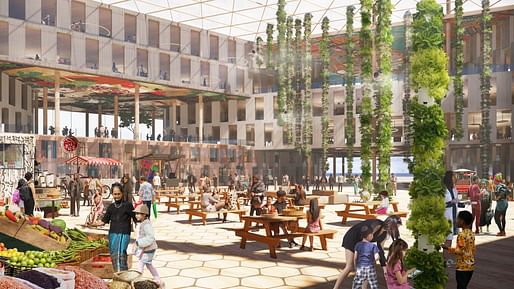
Further details have been revealed for the design of OCEANIX Busan, described as the “world’s first sustainable floating city.” Designed by lead architects BIG (Bjarke Ingels Group) and SAMOO (Samsung), the project will be constructed in the South Korean city of Busan by advanced maritime company OCEANIX in collaboration with UN-Habitat.

We first covered the project in 2019, when BIG unveiled the project as a utopian plan for floating cities, sparking extensive debate among our community. Late last year, it emerged that the city of Busan would take the lead on realizing the project. Now, new renderings of the scheme offer further insight into how the original utopian plan may manifest.
The current proposal would see interconnected platforms create a 15.5-acre city capable of accommodating 12,000 people. The scheme will be composed of various neighborhoods each with a particular focus including residential, research, and hospitality, while each platform is expected to host between 30,000 and 40,000 square meters (320,000 to 430,000 square feet) of mixed-use built space.

The scheme is expected to grow in phases, starting with a capacity fo 12,000 residents and visitors but eventually expanding to accommodate more than 100,000. The platforms will be connected to the land via a series of link-span bridges, while the architecture of the platform buildings will be defined by low-rise forms, soft lines, and indoor-outdoor terraces.

The floating city has also been designed to integrate zero waste and circular systems, closed loop water systems, food production via greenhouses, net zero energy, and coastal habitat regeneration. The team also claims the scheme will generate 100% of its required operational energy on-site through floating and rooftop solar panels, while each neighborhood will treat and replenish its own water, reduce and recycle resources, and include “innovative urban agriculture” systems.

“OCEANIX’s modular maritime neighborhood will be a prototype for sustainable and resilient cities,” said Bjarke Ingels on the news that the project was moving forward. “As our first manifestation of this new form of waterborne urbanism, OCEANIX Busan will expand the city’s unique character and culture from dryland into the water around it. We believe OCEANIX’s floating platforms can be developed at scale to serve as the foundations for future resilient communities in the most vulnerable coastal locations on the frontlines of climate change.”

News of the scheme comes in the same month that BIG won a competition for a research center in Seville operated by the European Commission. Also in April, our ongoing Job Highlights series focused on an opening for a presentation model shop assistant for the firm’s Brooklyn office.
1 Comment
I'm not seeing how the Phase I renderings of three smallish, mid-rise islands is able to accommodate 12,000 people.
Block this user
Are you sure you want to block this user and hide all related comments throughout the site?
Archinect
This is your first comment on Archinect. Your comment will be visible once approved.